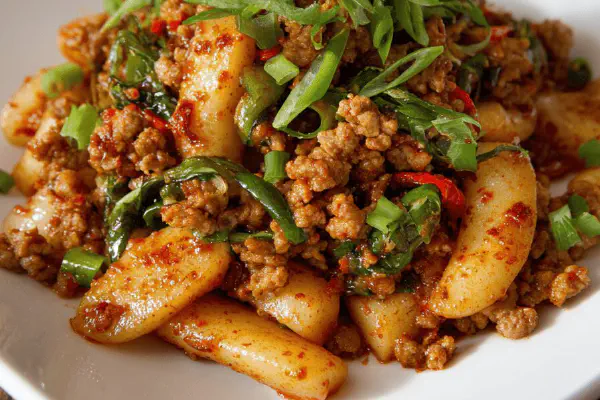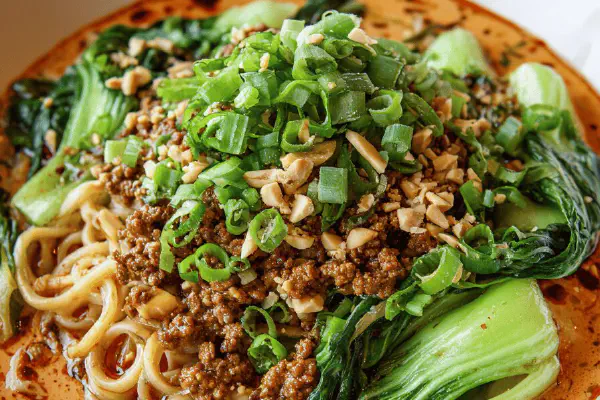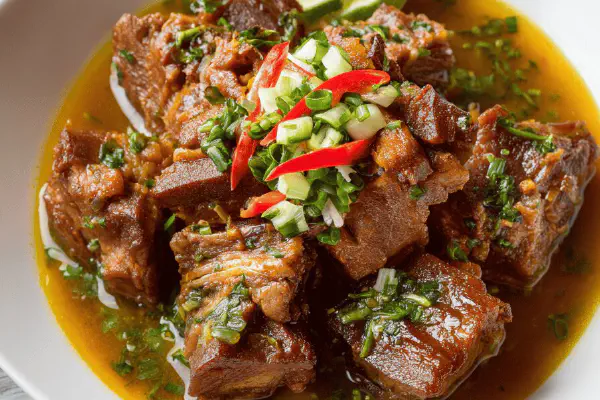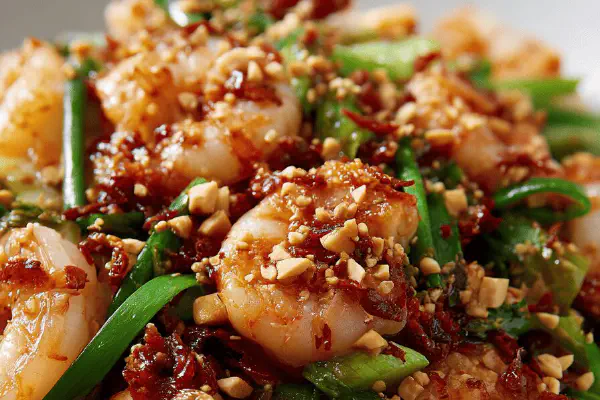Spicy Pork Rice Cakes

By Emma
Certified Culinary Professional
Ingredients
- 950 g sliced rice cakes (tteok)
- 60 ml mirin
- 60 ml water
- 60 ml fermented chili paste (gochujang)
- 15 ml toasted sesame oil
- 15 ml soy sauce
- 210 g lean ground pork
- 40 ml vegetable oil
- 2 red bell peppers, seeded and julienned
- 1 onion, thinly sliced
- 1 scallion, sliced
- 30 ml chopped fresh cilantro
About the ingredients
Method
- Start by placing rice cakes in a large bowl; cover with cold water and soak about 35 minutes at room temp. Aim for pliability without mushiness. The soaking water will be handy later.
- While soaking, whisk mirin, water, gochujang, sesame oil, and soy sauce in a bowl. This spicy-sweet tangy mix is the backbone. Taste it raw; it should hit salty, spicy, slightly sweet notes.
- Heat non-stick skillet on high; add half the vegetable oil. Crumble ground pork in—spread it out thinly so it browns instead of steams. Listen for sizzling; no liquid pooling—renders fat and browns bits in 5-7 minutes.
- Once the pork looks lightly seared and crumbly, toss in sliced peppers and onions. Stir-fry for 6 minutes until veggies soften but still hold crunch. Avoid limp veggies; they need snap. Remove the mixture onto a plate.
- Reserve 250 ml of soaking water; drain the rice cakes well. Don’t rinse. This starchy water helps thicken sauce and soften cakes.
- Wipe skillet, heat remaining oil on medium. Add drained rice cakes; stir gently for 6 minutes. Cakes will start to puff slightly, edges turning tender and sticky.
- Pour in reserved soaking water, simmer gently stirring for 4 minutes. Watch for cakes swelling, softening but not falling apart. The starchy water thickens now.
- Return pork and veggie mix to pan. Add mirin-gochujang sauce. Stir gently for 3-4 minutes, letting sauce thicken and coat everything in a glossy spicy glaze.
- Finish with fresh scallions and cilantro sprinkled on top for bright herbal punch. Serve right away; rice cakes firm up on cooling.
- Pro tip: if rice cakes are overly tough, soak longer or add a splash of water when reheating. For less heat, halve gochujang and add mild chili flakes later. Swap pork for ground chicken for lighter profile, or use avocado oil for milder scent. Avoid overcooking or cakes get gummy or dry. Stir constantly during final simmer to prevent sticking and ensure even coating.
- Watch colors—rich red sauce clings, pork browned, peppers vibrant but softened. Smell nutty sesame mingled with sharp chili and sweet mirin. Sound cues: sizzling during sear, gentle bubbling when simmering. Texture goal: chewy tender cakes, crisp-tender veggies, crumbly juicy pork. Timing flexible, rely on these signs over clocks.
Cooking tips
Chef's notes
- 💡 Soak rice cakes in cold water till pliable but not soggy. Timing varies; frozen needs longer soak or blanch quick. Keep soaking water—starchy, magic thickener later. Draining is key; no rinsing or lose starch advantage.
- 💡 Sear ground pork on high heat, spread thin, no crowding pan. Listen for sizzle; if liquid pools, pork steams not browns. Brown bits build flavor layers, don’t rush. Pork should shred crumbly, light sear with nutty fat rendering.
- 💡 Use medium heat for rice cakes after pork-veg remove. Add oil gently, stir slow so edges puff and get tender stickiness. Watch closely; edges changing color means ready to add soaking water. Slow simmer after pouring water for tender softening, sauce thickening.
- 💡 Increase or reduce gochujang based on heat preference. Lower it for milder spice and add subtle chili flakes later if wanted. Mirin brings slight sweetness and acidity; can swap with rice wine or dry sherry, but keep balance in check.
- 💡 Veggies keep crunch; no limp peppers or watery onions. Stir-fry just enough, 6 minutes usually hits crisp-tender. Remove from pan to prevent overcooking during sauce simmer. Fresh herbs finish cut through richness; swap cilantro for parsley if disliked.
Common questions
How long to soak rice cakes?
About 30-40 min room temp usually. Frozen ones can take longer or blanch fast. Too short means tough bites, too long mushy texture. Check softness with bite, adjust next time. Water temp matters–cold keeps starch tight, warm breaks down faster.
Can I use chicken instead of pork?
Yes, ground chicken or turkey works fine. Leaner, less fat means watch dryness. Add oils carefully to avoid dryness. Flavor adjusts naturally; may skip sear to avoid overcooking meat. Adjust spices if needed, chicken is milder so heat may feel stronger.
Why does sauce get too thin sometimes?
Usually missing starch from soaking water or drained rice cakes. Don’t rinse rice cakes after soaking. Add soaking water slowly while simmering; thickening takes minutes, watch texture. Over stirring when thickening can break sauce too. Alternative thickener? A small cornstarch slurry but kind of changes character.
How to store leftovers?
Refrigerate in airtight container up to 2 days. Rice cakes firm and toughen; reheat with splash water or broth to soften. Microwave or pan reheat on low, stirring often to avoid sticking. Freeze not ideal, texture degrades. For best, prepare fresh and portion.



